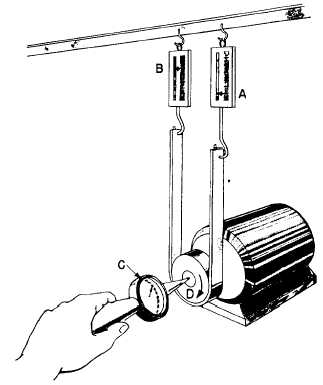Theoretically, the winch would have to work at a
rate of 12 horsepower to raise the anchor in 2 minutes.
Of course, you’ve left out all friction in this problem, so
the winch motor would actually have to be larger than
12 hp.
You raise planes from the hangar deck to the flight
deck of a carrier on an elevator. Some place along the
line, an engineer had to figure out how powerful the
motor had to be to raise the elevator. It’s not too tough
when you know how. Allow a weight of 10 tons for the
elevator and 5 tons for the plane. Suppose that you want
to raise the elevator and plane 25 feet in 10 seconds and
that the overall efficiency of the elevator mechanism is
70 percent. With that information you can figure what
the delivery horsepower of the motor must be. Set up
the formulas:
Substitute the known values in their proper places,
and you have:
So, you need 136.4 horsepower if the engine has 100
percent overall efficiency. You want to use 70 percent
efficiency, so you use the formula:
This is the rate at which the engine must be able to
work. To be on the safe side, you’d probably select a
200-horsepower auxiliary to do the job.
FIGURING THE HORSEPOWER
RATING OF A MOTOR
You have probably seen the horsepower rating plates
on electric motors. You may use several methods to
determine this rating. One way to find the rating of a
Figure 8-3.-A prony brake.
motor or a steam or gas engine is with the use of the
prony brake. Figure 8-3 shows you the prony brake
setup. A pulley wheel is attached to the shaft of the
motor and a leather belt is held firmly against the
pulley. Attached to the two ends of the belts are spring
scales. When the motor is standing still, each scale
reads the same— 15 points. When the pulley turns in a
clockwise direction, the friction between the belt and
the pulley makes the belt try to move with the pulley.
Therefore, the pull on scale A will be greater than
15 pounds, and the pull on scale B will be less than
15 pounds.
Suppose that scale A reads 25 pounds and scale B
reads 5 pounds. That tells you the drag, or the
force against which the motor is working, is
25 – 5 = 20 pounds. In this case the normal speed of
the motor is 1,800 revolutions per minute (rpm) and the
diameter of the pulley is 1 foot.
You can find the number of revolutions by holding
the revolution counter (fig. 8-3, C) against the end of the
shaft for 1 minute. This counter will record the number
of turns the shaft makes per minute. The distance
(D) that any point on the pulley travels in 1 minute is
8-3







